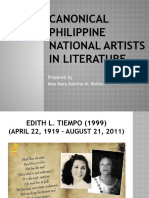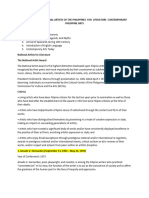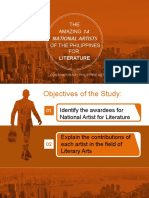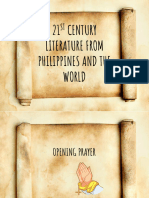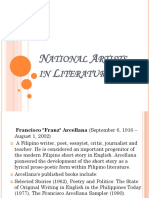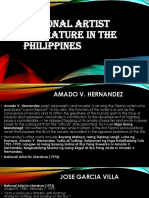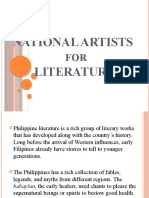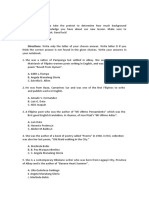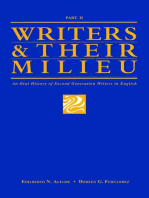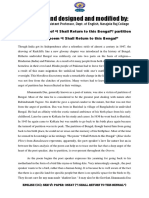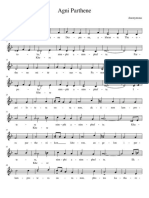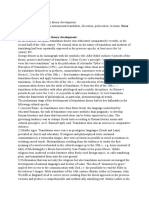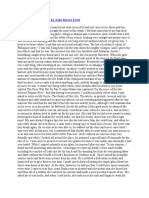0 ratings0% found this document useful (0 votes)
5 views21st-National-Artist
Uploaded by
reneljuzenlopezuy2Copyright
© © All Rights Reserved
Available Formats
Download as PPTX, PDF, TXT or read online on Scribd
0 ratings0% found this document useful (0 votes)
5 views21st-National-Artist
Uploaded by
reneljuzenlopezuy2Copyright
© © All Rights Reserved
Available Formats
Download as PPTX, PDF, TXT or read online on Scribd
You are on page 1/ 26
21 Century Literature
st
from the Philippines
and the World
National Artist for Literature
Objectives
The students are expected to:
• Identify the different National Artists for Literature
and their life works.
• Value the lifeworks of the National Artists for
Literature.
• Familiarize the life and lifeworks of the National
Artists for Literature.
• Appreciate the contributions of the National Artist
to the development of Philippine Literature.
National Artist
for Literature
Let’s learn!
The existence of literature in the
Philippines is evidently seen everywhere.
With the use of digital age producing and
writing literature is not difficult in the
21st Century.
Let’s learn!
However, many could write but hence
only few could be given the opportunity
to be recognized as one of the best in the
field of writing.
Let’s learn!
The National Artist for Literature is an
award given to those exemplary individuals
who gave immeasurable effort in writing
literature in which the soul and heart of
their writings were bound from reflecting
the Filipino culture, customs, and
traditions.
Let’s learn!
Moreover, these individuals are
considered to be those who gave
significant contributions to the
development of Philippine Literature.
1. Francisco Arcellana 8. Nick Joaquin
9. F. Sionil Jose
2. Virgilio S. Almario
10. Bienvenido Lumbera
3. Cirilo F. Bautista 11. Alejandro Roces
4. Levi Celerio 12. Edith L. Tiempo
5. Lazaro Francisco 13. Carlos P. Romulo
6. N.V.M Gonzalez 14. Rolando S. Tinio
7. Amado Vera Hernandez15. Jose Garcia Villa
Francisco Arcellana
• a writer, poet, essayist, critic, journalist and teacher, is one of the
most important progenitors of the modern Filipino short story in
English.
• He pioneered the development of the short story as a lyrical prose-
poetic form.
• the pride of fiction is “that it is able to render truth, that is able to
present reality”.
• Arcellana’s published books are Selected Stories (1962), Poetry and
Politics: The State of Original Writing in English in the Philippines
Today (1977), The Francisco Arcellana Sampler (1990).
Francisco Arcellana
• Some of his short stories are Frankie, The Man Who Would
Be Poe, Death in a Factory, Lina, A Clown Remembers,
Divided by Two, The Mats, and his poems being The Other
Woman, This Being the Third Poem This Poem is for
Mathilda, To Touch You and I Touched Her, among others.
Virgilio S. Almario
• Also known as Rio Alma, is a poet, literary historian and
critic, who has revived and reinvented traditional Filipino
poetic forms, even as he championed modernist poetics.
• In these works, his poetic voice soared from the lyrical to the
satirical to the epic, from the dramatic to the incantatory, in
his often severe examination of the self, and the society.
Cirilo F. Bautista
• As a way of bringing poetry and fiction closer to the people
who otherwise would not have the opportunity to develop
their creative talent, Bautista has been holding regular
funded and unfunded workshops throughout the country.
• As a teacher of literature, Bautista has realized that the
classroom is an important training ground for Filipino writers.
• Major works: Summer Suns (1963), Words and Battlefields
(1998), The Trilogy of Saint Lazarus (2001), Galaw ng Asoge
(2003).
Levi Celerio
• Levi Celerio is a prolific lyricist and composer for decades.
• Born in Tondo, Celerio received his scholarship at the
Academy of Music in Manila that made it possible for him to
join the Manila Symphony Orchestra, becoming its youngest
member. He made it to the Guinness Book of World Records
as the only person able to make music using just a leaf.
Lazaro Francisco
• Prize-winning writer Lazaro A. Francisco developed the social realist
tradition in Philippine fiction. His eleven novels, now acknowledged
classics of Philippine literature, embodies the author’s commitment
to nationalism.
• Francisco gained prominence as a writer not only for his social
conscience but also for his “masterful handling of the Tagalog
language” and “supple prose style”.
• is reputation as the “Master of the Tagalog Novel” is backed up by
numerous awards he received for his meritorious novels in particular,
and for his contribution to Philippine literature and culture in general.
NVM Gonzalez
• Nestor Vicente M. Gonzalez better known as N.V.M. Gonzalez,
fictionist, essayist, poet, and teacher, articulated the Filipino
spirit in rural, urban landscapes.
• Major works of N.V.M Gonzalez include the following: The
Winds of April, Seven Hills Away, Children of the Ash-Covered
Loam and Other Stories, The Bamboo Dancers, Look Stranger,
on this Island Now, Mindoro and Beyond: Twenty -One Stories,
The Bread of Salt and Other Stories, Work on the Mountain,
The Novel of Justice: Selected Essays 1968-1994, A Grammar of
Dreams and Other Stories.
Amado V. Hernandez
• In his view, the function of the writer is to act as the
conscience of society and to affirm the greatness of the
human spirit in the face of inequity and oppression.
• Hernandez’s contribution to the development of Tagalog
prose is considerable — he stripped Tagalog of its ornate
character and wrote in prose closer to the colloquial than the
“official” style permitted
Nick Joaquin
• Nick Joaquin (May 4, 1917 – April 29, 2004), is regarded by
many as the most distinguished Filipino writer in English
writing so variedly and so well about so many aspects of the
Filipino.
F. Sionil Jose
• In the five-novel masterpiece, the Rosales saga, consisting of
The Pretenders, Tree, My Brother, My Executioner, Mass, and
Po-on, he captures the sweep of Philippine history while
simultaneously narrating the lives of generations of the
Samsons whose personal lives intertwine with the social
struggles of the nation.
Bienvenido Lumbera
• Bienvenido Lumbera is a poet, librettist, and scholar.
• As a poet, he introduced to Tagalog literature what is now
known as Bagay poetry, a landmark aesthetic tendency that
has helped to change the vernacular poetic tradition.
• As a librettist for the Tales of the Manuvu and Rama Hari, he
pioneered the creative fusion of fine arts and popular
imagination.
Alejandro Roces
• Alejandro Roces is a short story writer and essayist, and
considered as the country’s best writer of comic short
stories.
• Ever the champion of Filipino culture, Roces brought to
public attention the aesthetics of the country’s fiestas. He
was instrumental in popularizing several local fiestas,
notably, Moriones and Ati-atihan.
Carlos P. Romulo
• Carlos P. Romulo’s multifaceted career spanned 50 years of
public service as educator, soldier, university president,
journalist and diplomat. It is common knowledge that he was
the first Asian president of the United Nations General
Assembly, then Philippine Ambassador to Washington, D.C.,
and later minister of foreign affairs.
• Romulo was very much into writing: he was a reporter at 16,
a newspaper editor by the age of 20, and a publisher at 32.
Rolando S. Tinio
• Rolando S. Tinio is a playwright, thespian, poet, teacher,
critic, and translator marked his career with prolific artistic
productions. Tinio’s chief distinction is as a stage director
whose original insights into the scripts he handled brought
forth productions notable for their visual impact and
intellectual cogency.
Edith L. Tiempo
• Edith L. Tiempo, poet, fictionist, teacher and literary critic is
one of the finest Filipino writers in English whose works are
characterized by a remarkable fusion of style and substance,
of craftsmanship and insight.
• Together with her late husband, Edilberto K. Tiempo, she
founded and directed the Silliman National Writers
Workshop in Dumaguete City, which has produced some of
the country’s best writers.
Jose Garcia Villa
• Jose Garcia Villa is considered as one of the finest
contemporary poets regardless of race or language.
• Villa’s works have been collected into the following books:
Footnote to Youth,Many Voices, Poems by Doveglion, Poems
55, Poems in Praise of Love: The Best Love Poems of Jose
Garcia Villa as Chosen By Himself, Selected Stories,The
Portable Villa, The Essential Villa, Mir-i-nisa, Storymasters 3:
Selected Stories from Footnote to Youth, 55 Poems: Selected
and Translated into Tagalog by Hilario S. Francia.
• As you read the biographies of these extraordinary writers
you will understand that receiving this award is not just to
add feather on one’s cap or to add achievement to one’s
resume. The National Artist Award for Literature is an award
that does not end or start in the day that the award is
bestowed by the President of the Philippines to an
individual.
• This kind of recognition is accompanied by a lifelong
responsibility – a responsibility to express truth and reflect
truth – which were evident from their writings. Thus,
literature in its purest nature reflects truth and reality about
life.
You might also like
- AP Literature and Composition - Frankenstein Prose Prompt40% (5)AP Literature and Composition - Frankenstein Prose Prompt2 pages
- 1.1 Canonical Philippine National Artists in Literature100% (4)1.1 Canonical Philippine National Artists in Literature4 pages
- Critical Terms For Literary Study - Int. and Ch. 11 Unconscious100% (1)Critical Terms For Literary Study - Int. and Ch. 11 Unconscious30 pages
- Vergilius, Aeneid (Eneida) 1-4 - Clyde Pharr - Vergil's Aeneid - Books I-VI, With Introduction, Notes, Vocabulary, and Grammatical appendix-D.C. Heath and Co (1930)100% (3)Vergilius, Aeneid (Eneida) 1-4 - Clyde Pharr - Vergil's Aeneid - Books I-VI, With Introduction, Notes, Vocabulary, and Grammatical appendix-D.C. Heath and Co (1930)540 pages
- Canonical Authors and Works of Philippine National Artists83% (6)Canonical Authors and Works of Philippine National Artists36 pages
- National Artist of The Philippines Literature: Amado Vera Hernandez (1973)No ratings yetNational Artist of The Philippines Literature: Amado Vera Hernandez (1973)4 pages
- MODULE 5. National Artist For Literature - Lecture100% (2)MODULE 5. National Artist For Literature - Lecture3 pages
- Philippine National Artists in LiteratureNo ratings yetPhilippine National Artists in Literature9 pages
- Canonical Philippine National Artists in Literature: Prepared by Miss Mary Katrine M. BelinoNo ratings yetCanonical Philippine National Artists in Literature: Prepared by Miss Mary Katrine M. Belino51 pages
- National Artist of The Phlippines in LiteratureNo ratings yetNational Artist of The Phlippines in Literature25 pages
- Module 6: The National Artists of The Philippines For LiteratureNo ratings yetModule 6: The National Artists of The Philippines For Literature31 pages
- The Amazing 16 National Artists of The Philippines For Literature Contemporary Philippine ArtsNo ratings yetThe Amazing 16 National Artists of The Philippines For Literature Contemporary Philippine Arts12 pages
- National Artist of The Phil. LiteratureNo ratings yetNational Artist of The Phil. Literature92 pages
- I. Preliminaries: Authors and Works of National Artists in LiteratureNo ratings yetI. Preliminaries: Authors and Works of National Artists in Literature9 pages
- M6 The National Artists of The Philippines For LiteratureNo ratings yetM6 The National Artists of The Philippines For Literature19 pages
- Canonical Authors and Works of The Philippine National Artists in LiteratureNo ratings yetCanonical Authors and Works of The Philippine National Artists in Literature5 pages
- Canonical Authors and Works of Philippine National Artist in LiteratureNo ratings yetCanonical Authors and Works of Philippine National Artist in Literature53 pages
- In Literature: Philippine National ArtistsNo ratings yetIn Literature: Philippine National Artists51 pages
- And Works of Philippine National Artists in LiteratureNo ratings yetAnd Works of Philippine National Artists in Literature47 pages
- Aiming For Nothing, and Landing On The Sun." - Doveglion: Collected Poem100% (1)Aiming For Nothing, and Landing On The Sun." - Doveglion: Collected Poem4 pages
- Prepared by Miss Mary Katrine M. BelinoNo ratings yetPrepared by Miss Mary Katrine M. Belino51 pages
- National Artist Literature in The PhilippinesNo ratings yetNational Artist Literature in The Philippines15 pages
- Canonical Authors and Works of Philippine National Artists in LiteratureNo ratings yetCanonical Authors and Works of Philippine National Artists in Literature6 pages
- Lesson 10 National Artists For LiteratureNo ratings yetLesson 10 National Artists For Literature41 pages
- Canonical Authors and Works of Philippine National Artists in Literature50% (2)Canonical Authors and Works of Philippine National Artists in Literature33 pages
- Canonical Authors and National Artists in LiteratureNo ratings yetCanonical Authors and National Artists in Literature47 pages
- Writers and Their Milieu: An Oral History of Second Generation Writers in English, Part 2From EverandWriters and Their Milieu: An Oral History of Second Generation Writers in English, Part 22/5 (1)
- Compiled and Designed and Modified By:: Mr. Milan Mondal, Assistant Professor, Dept. of English, Narajole Raj CollegeNo ratings yetCompiled and Designed and Modified By:: Mr. Milan Mondal, Assistant Professor, Dept. of English, Narajole Raj College3 pages
- James Evans - Comedy and Criticism - 1987 Obs PDF100% (2)James Evans - Comedy and Criticism - 1987 Obs PDF432 pages
- Unveiling The Veil: Critical Study of The Two Poems "Purdah I &II" of Imtiaz DharkerNo ratings yetUnveiling The Veil: Critical Study of The Two Poems "Purdah I &II" of Imtiaz Dharker10 pages
- Agni Parthene: Nectarios of Aegina Anonymous 120No ratings yetAgni Parthene: Nectarios of Aegina Anonymous 1202 pages
- Onomatopoeia Poetry: Learning ObjectivesNo ratings yetOnomatopoeia Poetry: Learning Objectives5 pages
- Introduction to East African Oral Literature NotesNo ratings yetIntroduction to East African Oral Literature Notes89 pages
- Article HUTCHINSON - New & Old Light On Reasons For Ov.'s Exile - ZPE 203 (2017)No ratings yetArticle HUTCHINSON - New & Old Light On Reasons For Ov.'s Exile - ZPE 203 (2017)10 pages
- The Soul's Whisper - Poems by Biswajit DashNo ratings yetThe Soul's Whisper - Poems by Biswajit Dash29 pages
- Poems and Songs of Robert Burns by Burns, Robert, 1759-1796100% (2)Poems and Songs of Robert Burns by Burns, Robert, 1759-1796587 pages
- Рибовалова Periods of the translation theory developmentNo ratings yetРибовалова Periods of the translation theory development25 pages
- Cyrano de Bergerac (Edmond Rostand, Brian Hooker)No ratings yetCyrano de Bergerac (Edmond Rostand, Brian Hooker)286 pages
- Tet Success Key 7/09/2018 English Literature English NET Exam Notes100% (1)Tet Success Key 7/09/2018 English Literature English NET Exam Notes7 pages













